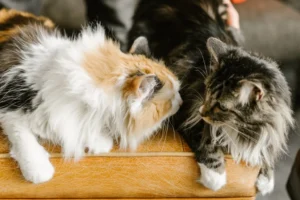Cats are known for their playful antics, but have you ever wondered why they sometimes hit without using their claws? Let’s explore the reasons behind this common feline behavior.
Have you ever noticed your cat playfully swatting at you or another pet without actually using their claws? This behavior is often seen during playtime or when the cat is feeling excited. Cats have a natural instinct to play and engage in mock fighting, and hitting without claws is a way for them to engage in this behavior without causing harm.
Have you ever noticed your feline friend swatting at your hand or a toy without using their claws? This behavior is often a playful gesture from your cat, similar to how kittens engage with each other during playtime. Playful hitting without claws is their way of interacting with you or expressing their desire for interaction.
Cats are natural hunters, and this playful hitting mimics their instinctual behavior of swatting at prey. It’s their way of engaging with you in a light-hearted manner, showing affection, and enjoying bonding time together. So next time your cat playfully hits at you without claws, know that it’s their way of expressing joy and wanting to play.
For more insight into why cats exhibit playful hitting behavior without claws, you can refer to the American Veterinary Medical Association’s article on feline behavior.
Communication: Hitting without claws can be a way for cats to communicate their feelings or establish boundaries.
When a cat hits without using their claws, it may be a form of communication to express their mood or set boundaries. Non-aggressive hitting without claws is a way for cats to convey their emotions, whether they’re feeling playful, seeking attention, or indicating they’ve had enough interaction.
Cats are sensitive creatures with their unique ways of communicating. A gentle tap without claws might be their way of saying they want to play or cuddle with you. On the other hand, repeated firm hits without claws could signal that they’re feeling overstimulated or need some personal space.
Understanding your cat’s body language and recognizing their hitting behavior without claws can help strengthen your bond and ensure harmonious interactions. Next time your feline companion gently taps at you, take the time to observe their signals and respond accordingly to foster a positive relationship.
Remember, every cat is different, so being attentive to your cat’s hitting habits without claws can help you decipher their unique way of expressing themselves.
Instinctual Behavior:
Cats hitting without claws is often rooted in their natural instincts and hunting behaviors. Since cats use their paws to catch prey in the wild, this behavior can be a way for them to play or simulate hunting. It’s important to understand that this behavior is not intended to harm you, but rather a way for your furry friend to engage in their innate behaviors. Providing interactive toys and playtime can help satisfy their hunting instincts and minimize such behaviors.
Stress or Aggression:
In some cases, hitting without claws can be a sign of stress or aggression in cats. Cats may resort to this behavior when they feel anxious, threatened, or overwhelmed. It’s crucial to observe your cat’s body language and the context of the situation to determine the underlying cause. If you notice your cat showing signs of stress or aggression, create a calm and safe environment for them. Providing hiding spots, vertical spaces, and interactive toys can help alleviate stress and reduce aggressive behaviors.
Unique Insight:
When cats hit without claws, it can also be a form of communication. Instead of using vocalizations, some cats may use gentle pawing to get your attention or express affection. Pay attention to your cat’s body language and the situation to decipher the message they are trying to convey. Understanding your cat’s communication cues can strengthen your bond and enhance your relationship with your feline companion.
- Provide interactive toys: Engage your cat in playtime with interactive toys to satisfy their natural hunting instincts.
- Observe body language: Pay attention to your cat’s body language to understand the underlying cause of hitting without claws.
- Create a calm environment: Ensure your cat has a calm and stress-free environment to minimize aggressive behaviors.
- Understanding communication: Cats may use gentle pawing as a form of communication, so be attentive to their cues.
For more information on cat behaviors and communication, you can refer to the ASPCA’s guide on Understanding Cat Behavior at ASPCA Guide.
Training Tips: Tips for redirecting this behavior and encouraging positive interactions with your cat.
If your cat is hitting you without using their claws, it could be a sign of play aggression or overstimulation. One effective way to redirect this behavior is by providing appropriate toys for your cat to play with instead. Use interactive toys like feather wands or laser pointers to engage your cat in a more suitable outlet for their energy.
Another essential training tip is to establish routine play sessions with your cat. By engaging in regular playtime, you can help your cat release excess energy and reduce the likelihood of them resorting to hitting. Remember to always reward positive behaviors during play, like gentle touches or playing with toys appropriately.
Additionally, consider creating a safe space for your cat where they can retreat when feeling overwhelmed. Cats often hit out of stress or discomfort, so providing a quiet area with cozy bedding can help them feel secure and relaxed.
Providing Enrichment: The importance of providing mental and physical stimulation for your cat to prevent unwanted behaviors.
Ensuring your cat receives enough mental and physical stimulation is crucial in preventing behaviors like hitting without claws. Cats are naturally curious and playful animals, so offering a variety of toys, scratching posts, and interactive feeders can keep them mentally engaged and physically active.
In addition to toys, consider introducing puzzle feeders or hiding treats around your home to encourage your cat’s natural hunting instincts. This mental stimulation can help prevent boredom, which is often a leading cause of unwanted behaviors in cats.
Furthermore, set up a cat-friendly environment with plenty of vertical space for climbing and exploring. Cats love to perch up high and observe their surroundings, so providing cat trees or shelves can satisfy their need for vertical territory and mental stimulation.
List of helpful tips for providing enrichment for your cat: – Rotate and introduce new toys regularly to keep your cat engaged – Offer window perches or cat shelves for vertical exploration – Consider using catnip or interactive puzzles to stimulate your cat mentally – Schedule regular playtime sessions to bond with your cat and encourage positive behaviors
Remember, a happy and stimulated cat is less likely to exhibit behaviors like hitting without claws. By providing ample enrichment and training, you can create a harmonious relationship with your feline companion.
Understanding Body Language
Have you ever wondered why your cat hits you without using their claws? Understanding your cat’s body language can provide valuable insights into their emotions and needs. When a cat gently taps you with their paw without extending their claws, they may be seeking your attention or trying to initiate play. This behavior is often a sign of affection and can be their way of bonding with you.
Key Signs to Look for:
- Ears forward or slightly to the side: Indicates curiosity or friendliness.
- Tail held high or twitching: Shows excitement or happiness.
- Relaxed body posture: Signifies comfort and trust.
Remember, every cat is unique, so it’s essential to pay attention to your cat’s specific cues and behaviors to better understand their feelings. By learning to read your cat’s body language, you can strengthen your bond and communicate effectively with your furry companion.
Seeking Professional Help
If your cat’s hitting behavior becomes aggressive or threatening, it may be time to seek professional help from a veterinarian or animal behaviorist. Aggression in cats can have various underlying causes, such as fear, stress, or medical issues. A professional can assess your cat’s behavior, provide expert guidance, and develop a tailored plan to address the issue.
Signs that warrant professional intervention:
- Hissing, growling, or biting during interactions.
- Increased frequency or intensity of hitting.
- Changes in appetite, grooming habits, or litter box use.
Don’t hesitate to reach out for help if you’re concerned about your cat’s behavior. A trained expert can offer valuable insights and support to ensure your cat’s well-being and happiness.
Alex, a passionate animal lover, has experience in training and understanding animal behavior. As a proud pet parent to two dogs and three cats, he founded AnimalReport.net to share insights from animal experts and expand his knowledge of the animal kingdom.









